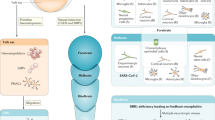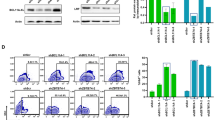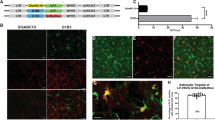Abstract
Ongoing neurogenesis in discrete sectors of the adult central nervous system depends on the mitotic activity of an elusive population of adult stem cells. The existence of adult neural stem cells provides an alternative approach to transplantation of embryonic stem cells in cell-based therapies. Owing to the limited intrinsic fate of adult stem cells and inhibitory nature of the adult brain for neurogenesis, accommodation for circuit replacement in the brain will require genetic and epigenetic manipulation. Here, we show that a replication-incompetent Equine Infectious Anemia Virus (EIAV) is highly suitable for stable and persistent gene transfer to adult neural stem cells. The transduced regions were free of long-lasting neuroimmune responses to EIAV. Transduction in the subventricular zone was specific to the stem cell niche, but spared the progeny of adult neural stem cells that includes transit amplifying progenitors (TAPs) and migrating neuroblasts. With time, EIAV-transduced stem cells passed on the transgene to TAPs and migrating neuroblasts, which ultimately differentiated into neurons in the olfactory bulbs. We show that EIAV is highly suitable for discovery and assessment of mechanisms that regulate proliferation, migration and differentiation in the postnatal brain.
This is a preview of subscription content, access via your institution
Access options
Subscribe to this journal
Receive 12 print issues and online access
$259.00 per year
only $21.58 per issue
Buy this article
- Purchase on Springer Link
- Instant access to full article PDF
Prices may be subject to local taxes which are calculated during checkout







Similar content being viewed by others
References
Bhardwaj RD, Curtis MA, Spalding KL, Buchholz BA, Fink D, Bjork-Eriksson T et al. Neocortical neurogenesis in humans is restricted to development. Proc Natl Acad Sci USA 2006; 103: 12564–12568.
Rakic P . Neurogenesis in adult primate neocortex: an evaluation of the evidence. Nat Rev Neurosci 2002; 3: 65–71.
Lledo PM, Merkle FT, Alvarez-Buylla A . Origin and function of olfactory bulb interneuron diversity. Trends Neurosci 2008; 31: 392–400.
Duan X, Kang E, Liu CY, Ming GL, Song H . Development of neural stem cell in the adult brain. Curr Opin Neurobiol 2008; 18: 108–115.
Curtis MA, Kam M, Nannmark U, Anderson MF, Axell MZ, Wikkelso C et al. Human neuroblasts migrate to the olfactory bulb via a lateral ventricular extension. Science 2007; 315: 1243–1249.
Emsley JG, Mitchell BD, Kempermann G, Macklis JD . Adult neurogenesis and repair of the adult CNS with neural progenitors, precursors, and stem cells. Prog Neurobiol 2005; 75: 321–341.
Abrahams JM, Gokhan S, Flamm ES, Mehler MF . De novo neurogenesis and acute stroke: are exogenous stem cells really necessary? Neurosurgery 2004; 54: 150–155.
Ghashghaei HT, Lai C, Anton ES . Neuronal migration in the adult brain: are we there yet? Nat Rev Neurosci 2007; 8: 141–151.
Li JY, Englund E, Holton JL, Soulet D, Hagell P, Lees AJ et al. Lewy bodies in grafted neurons in subjects with Parkinson′s disease suggest host-to-graft disease propagation. Nat Med 2008; 14: 501–503.
Barker RA, Widner H . Immune problems in central nervous system cell therapy. NeuroRx 2004; 1: 472–481.
McConnell SK . Fates of visual cortical neurons in the ferret after isochronic and heterochronic transplantation. J Neurosci 1988; 8: 945–974.
Ninkovic J, Gotz M . Signaling in adult neurogenesis: from stem cell niche to neuronal networks. Curr Opin Neurobiol 2007; 17: 338–344.
Guillemot F . Cell fate specification in the mammalian telencephalon. Prog Neurobiol 2007; 83: 37–52.
Davidson BL, Breakefield XO . Viral vectors for gene delivery to the nervous system. Nat Rev Neurosci 2003; 4: 353–364.
Waehler R, Russell SJ, Curiel DT . Engineering targeted viral vectors for gene therapy. Nat Rev Genet 2007; 8: 573–587.
Tabata H, Nakajima K . Efficient in utero gene transfer system to the developing mouse brain using electroporation: visualization of neuronal migration in the developing cortex. Neuroscience 2001; 103: 865–872.
Barnabe-Heider F, Meletis K, Eriksson M, Bergmann O, Sabelstrom H, Harvey MA et al. Genetic manipulation of adult mouse neurogenic niches by in vivo electroporation. Nat Methods 2008; 5: 189–196.
Geraerts M, Eggermont K, Hernandez-Acosta P, Garcia-Verdugo JM, Baekelandt V, Debyser Z . Lentiviral vectors mediate efficient and stable gene transfer in adult neural stem cells in vivo. Hum Gene Therapy 2006; 17: 635–650.
Colak D, Mori T, Brill MS, Pfeifer A, Falk S, Deng C et al. Adult neurogenesis requires Smad4-mediated bone morphogenic protein signaling in stem cells. J Neurosci 2008; 28: 434–446.
Suh H, Consiglio A, Ray J, Sawai T, D′Amour KA, Gage FH . In vivo fate analysis reveals the multipotent and self-renewal capacities of Sox2+ neural stem cells in the adult hippocampus. Cell Stem Cell 2007; 1: 515–528.
Alonso M, Ortega-Perez I, Grubb MS, Bourgeois JP, Charneau P, Lledo PM . Turning astrocytes from the rostral migratory stream into neurons: a role for the olfactory sensory organ. J Neurosci 2008; 28: 11089–11102.
Consiglio A, Gritti A, Dolcetta D, Follenzi A, Bordignon C, Gage FH et al. Robust in vivo gene transfer into adult mammalian neural stem cells by lentiviral vectors. Proc Natl Acad Sci USA 2004; 101: 14835–14840.
Olsen JC . Gene transfer vectors derived from equine infectious anemia virus. Gene Therapy 1998; 5: 1481–1487.
O’Rourke JP, Olsen JC, Bunnell BA . Optimization of equine infectious anemia derived vectors for hematopoietic cell lineage gene transfer. Gene Therapy 2005; 12: 22–29.
Mazarakis ND, Azzouz M, Rohll JB, Ellard FM, Wilkes FJ, Olsen AL et al. Rabies virus glycoprotein pseudotyping of lentiviral vectors enables retrograde axonal transport and access to the nervous system after peripheral delivery. Hum Mol Genet 2001; 10: 2109–2121.
Merkle FT, Mirzadeh Z, Alvarez-Buylla A . Mosaic organization of neural stem cells in the adult brain. Science 2007; 317: 381–384.
Tramontin AD, Garcia-Verdugo JM, Lim DA, Alvarez-Buylla A . Postnatal development of radial glia and the ventricular zone (VZ): a continuum of the neural stem cell compartment. Cereb Cortex 2003; 13: 580–587.
Hartfuss E, Galli R, Heins N, Gotz M . Characterization of CNS precursor subtypes and radial glia. Dev Biol 2001; 229: 15–30.
Spassky N, Merkle FT, Flames N, Tramontin AD, Garcia-Verdugo JM, Alvarez-Buylla A . Adult ependymal cells are postmitotic and are derived from radial glial cells during embryogenesis. J Neurosci 2005; 25: 10–18.
Doetsch F, Petreanu L, Caille I, Garcia-Verdugo JM, Alvarez-Buylla A . EGF converts transit-amplifying neurogenic precursors in the adult brain into multipotent stem cells. Neuron 2002; 36: 1021–1034.
Holmberg J, Genander M, Halford MM, Anneren C, Sondell M, Chumley MJ et al. EphB receptors coordinate migration and proliferation in the intestinal stem cell niche. Cell 2006; 125: 1151–1163.
Reynolds BA, Weiss S . Generation of neurons and astrocytes from isolated cells of the adult mammalian central nervous system. Science 1992; 255: 1707–1710.
Richards LJ, Kilpatrick TJ, Bartlett PF . De novo generation of neuronal cells from the adult mouse brain. Proc Natl Acad Sci USA 1992; 89: 8591–8595.
Anton ES, Ghashghaei HT, Weber JL, McCann C, Fischer TM, Cheung ID et al. Receptor tyrosine kinase ErbB4 modulates neuroblast migration and placement in the adult forebrain. Nat Neurosci 2004; 7: 1319–1328.
Ghashghaei HT, Weber J, Pevny L, Schmid R, Schwab MH, Lloyd KC et al. The role of neuregulin-ErbB4 interactions on the proliferation and organization of cells in the subventricular zone. Proc Natl Acad Sci USA 2006; 103: 1930–1935.
Wong LF, Goodhead L, Prat C, Mitrophanous KA, Kingsman SM, Mazarakis ND . Lentivirus-mediated gene transfer to the central nervous system: therapeutic and research applications. Hum Gene Ther 2006; 17: 1–9.
Johansson CB, Momma S, Clarke DL, Risling M, Lendahl U, Frisen J . Identification of a neural stem cell in the adult mammalian central nervous system. Cell 1999; 96: 25–34.
Coskun V, Wu H, Blanchi B, Tsao S, Kim K, Zhao J et al. CD133+ neural stem cells in the ependyma of mammalian postnatal forebrain. Proc Natl Acad Sci USA 2008; 105: 1026–1031.
Doetsch F, Caille I, Lim DA, Garcia-Verdugo JM, Alvarez-Buylla A . Subventricular zone astrocytes are neural stem cells in the adult mammalian brain. Cell 1999; 97: 703–716.
Ganat YM, Silbereis J, Cave C, Ngu H, Anderson GM, Ohkubo Y et al. Early postnatal astroglial cells produce multilineage precursors and neural stem cells in vivo. J Neurosci 2006; 26: 8609–8621.
Kruger RP, Aurandt J, Guan KL . Semaphorins command cells to move. Nat Rev Mol Cell Biol 2005; 6: 789–800.
de Castro F, Hu L, Drabkin H, Sotelo C, Chedotal A . Chemoattraction and chemorepulsion of olfactory bulb axons by different secreted semaphorins. J Neurosci 1999; 19: 4428–4436.
Schwarting GA, Kostek C, Ahmad N, Dibble C, Pays L, Puschel AW . Semaphorin 3A is required for guidance of olfactory axons in mice. J Neurosci 2000; 20: 7691–7697.
Lemasson M, Saghatelyan A, Olivo-Marin JC, Lledo PM . Neonatal and adult neurogenesis provide two distinct populations of newborn neurons to the mouse olfactory bulb. J Neurosci 2005; 25: 6816–6825.
Kuhn HG, Dickinson-Anson H, Gage FH . Neurogenesis in the dentate gyrus of the adult rat: age-related decrease of neuronal progenitor proliferation. J Neurosci 1996; 16: 2027–2033.
Petreanu L, Alvarez-Buylla A . Maturation and death of adult-born olfactory bulb granule neurons: role of olfaction. J Neurosci 2002; 22: 6106–6113.
De Marchis S, Bovetti S, Carletti B, Hsieh YC, Garzotto D, Peretto P et al. Generation of distinct types of periglomerular olfactory bulb interneurons during development and in adult mice: implication for intrinsic properties of the subventricular zone progenitor population. J Neurosci 2007; 27: 657–664.
Hayes NL, Nowakowski RS . Dynamics of cell proliferation in the adult dentate gyrus of two inbred strains of mice. Brain Res Dev Brain Res 2002; 134: 77–85.
Mouret A, Gheusi G, Gabellec MM, de Chaumont F, Olivo-Marin JC, Lledo PM . Learning and survival of newly generated neurons: when time matters. J Neurosci 2008; 28: 11511–11516.
Lledo PM, Lazarini F . Neuronal replacement in microcircuits of the adult olfactory system. C R Biol 2007; 330: 510–520.
Stiles CD, Rowitch DH . Glioma stem cells: a midterm exam. Neuron 2008; 58: 832–846.
Acknowledgements
We thank Dr David Eisenstat (University of Manitoba) for providing the DLX2 antibody. We are grateful to Dr Roman Giger (University of Michigan) for providing the Sema3A construct. Drs Rick Meeker (UNC-Chapel Hill) and Lola Hudson (North Carolina State University) provided invaluable antibodies and discussion on neuroimmune and neuroinflammatory responses to EIAV. Natalie Surzenko helped with the NRG2 analysis. We also thank Dr Chris McGahan for critical reading of the manuscript. JCO acknowledges research support from the National Institutes of Health HL 51818 and sponsored research funds from the Oxford BioMedica Ltd. The initial stages of this work was supported by National Institute of Health Grant MH060929 to ESA. Most of this work was supported by NCSU start up funds to TG.
Author information
Authors and Affiliations
Corresponding author
Additional information
Supplementary Information accompanies the paper on Gene Therapy website (http://www.nature.com/gt)
Supplementary information
Rights and permissions
About this article
Cite this article
Jacquet, B., Patel, M., Iyengar, M. et al. Analysis of neuronal proliferation, migration and differentiation in the postnatal brain using equine infectious anemia virus-based lentiviral vectors. Gene Ther 16, 1021–1033 (2009). https://doi.org/10.1038/gt.2009.58
Received:
Revised:
Accepted:
Published:
Issue Date:
DOI: https://doi.org/10.1038/gt.2009.58



